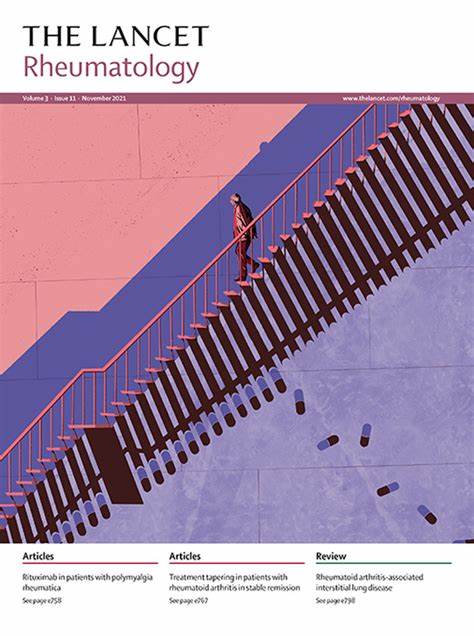Addition of aerobic physical activity to resistance exercise for hip osteoarthritis (PHOENIX): a randomised comparative effectiveness trial
IF 15
1区 医学
Q1 RHEUMATOLOGY
引用次数: 0
Abstract
Background
Exercise is recommended for hip osteoarthritis, but the most effective programmes for management of symptoms are unknown. We aimed to investigate whether adding aerobic physical activity to resistance exercise would improve hip pain and function more than resistance exercise alone in individuals with hip osteoarthritis.
Methods
PHOENIX was a randomised comparative effectiveness trial done in Melbourne, Australia. We recruited people with a clinical diagnosis of symptomatic hip osteoarthritis. Participants were randomly assigned (1:1, by use of a web-based system) to aerobic physical activity and resistance exercise or resistance exercise only. Both groups received a home exercise programme and nine consultations with a physiotherapist over 3 months. The co-primary outcomes were change in hip pain severity (numerical rating scale [NRS] 0–10, with higher scores indicating worse outcomes) and function (Western Ontario and McMaster Osteoarthritis Index [WOMAC]; scale 0–68, with higher scores indicating worse outcomes) at 3 months. Analyses were done in the intention-to-treat population. People with lived experience of hip osteoarthritis were involved in the design of the study. This trial is registered with the Australian New Zealand Clinical Trial Registry (ACTRN 12619001297112), and is complete.
Findings
Between Oct 15, 2019, and Sept 13, 2022, 196 participants (134 [68%] women and 62 [32%] men) were randomly assigned to aerobic physical activity and resistance exercise (n=97) or resistance exercise only (n=99). At 3 months, aerobic physical activity and resistance exercise was not more effective in improving hip pain severity (mean difference 0·3 [95% CI –0·3 to 0·8; p=0·36]) or function (mean difference –0·9 [95% CI –3·6 to 1·8; p=0·51]) compared with resistance exercise alone, with both showing a mean improvement in pain (2·4 [SD 1·9] with aerobic physical activity and resistance exercise vs 2·2 [2·1] with resistance exercise only) and function (7·0 [10·4] with aerobic physical activity and resistance exercise vs 8·9 [10·8] resistance exercise only). There were 24 related adverse events with aerobic physical activity and resistance exercise, and 31 with resistance exercise only, none of which were serious.
Interpretation
Despite improvement in pain and function in both groups, adding moderate-intensity aerobic physical activity to resistance exercise did not lead to superior outcomes. Future work could consider higher intensity interval training before concluding no symptomatic benefit of adding aerobic exercise or physical activity to resistance exercise.
Funding
National Health and Medical Research Council, Australia.
在抗阻运动中加入有氧运动治疗髋关节骨关节炎(PHOENIX):一项随机比较疗效试验。
背景:运动被推荐用于治疗髋关节骨关节炎,但最有效的治疗方案尚不清楚。我们的目的是研究在抗阻运动中加入有氧运动是否比单独抗阻运动更能改善髋关节疼痛和功能。方法:PHOENIX是一项在澳大利亚墨尔本进行的随机比较有效性试验。我们招募了临床诊断为症状性髋关节骨关节炎的人。参与者被随机分配(1:1,使用基于网络的系统)进行有氧运动和阻力运动或仅进行阻力运动。两组都接受了一个家庭锻炼计划,并在3个月内与物理治疗师进行了9次咨询。共同主要结局是髋关节疼痛严重程度(数值评定量表[NRS] 0-10,分数越高表明结果越差)和功能(Western Ontario and McMaster Osteoarthritis Index [WOMAC];量表为0-68,得分越高表明结果越差)。在意向治疗人群中进行分析。有髋关节骨关节炎生活经验的人参与了这项研究的设计。该试验已在澳大利亚新西兰临床试验注册中心注册(ACTRN 12619001297112),并且已经完成。研究结果:在2019年10月15日至2022年9月13日期间,196名参与者(134名[68%]女性和62名[32%]男性)被随机分配到有氧运动和阻力运动(n=97)或仅进行阻力运动(n=99)。在3个月时,有氧运动和阻力运动在改善髋关节疼痛严重程度方面并没有更有效(平均差值为0.3 [95% CI - 0.3 ~ 0.8;p= 0.36])或功能(平均差值- 0.9 [95% CI - 3.6至1.8;p= 0.51])与单纯阻力运动相比,两者均显示出疼痛的平均改善(有氧运动和阻力运动组为2.4 [SD 1.9],而单纯阻力运动组为2.2 [SD 2.1])和功能的平均改善(有氧运动和阻力运动组为7.0[10.4],而单纯阻力运动组为8.9[10.8])。有氧运动加抗阻运动相关不良事件24例,单纯抗阻运动相关不良事件31例,均无严重不良事件。解释:尽管两组患者的疼痛和功能都有所改善,但在抗阻运动中加入中等强度的有氧运动并没有带来更好的结果。未来的工作可以考虑更高强度的间歇训练,然后再得出结论,在抗阻运动中加入有氧运动或身体活动对症状没有好处。资助:澳大利亚国家卫生和医学研究委员会。
本文章由计算机程序翻译,如有差异,请以英文原文为准。
求助全文
约1分钟内获得全文
求助全文
来源期刊

Lancet Rheumatology
RHEUMATOLOGY-
CiteScore
34.70
自引率
3.10%
发文量
279
期刊介绍:
The Lancet Rheumatology, an independent journal, is dedicated to publishing content relevant to rheumatology specialists worldwide. It focuses on studies that advance clinical practice, challenge existing norms, and advocate for changes in health policy. The journal covers clinical research, particularly clinical trials, expert reviews, and thought-provoking commentary on the diagnosis, classification, management, and prevention of rheumatic diseases, including arthritis, musculoskeletal disorders, connective tissue diseases, and immune system disorders. Additionally, it publishes high-quality translational studies supported by robust clinical data, prioritizing those that identify potential new therapeutic targets, advance precision medicine efforts, or directly contribute to future clinical trials.
With its strong clinical orientation, The Lancet Rheumatology serves as an independent voice for the rheumatology community, advocating strongly for the enhancement of patients' lives affected by rheumatic diseases worldwide.
 求助内容:
求助内容: 应助结果提醒方式:
应助结果提醒方式:


